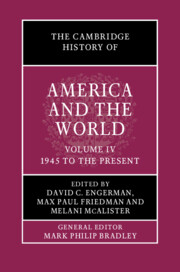Book contents
- The Cambridge History of America and the World
- The Cambridge History of America and the World
- The Cambridge History of America and the World
- Copyright page
- Contents
- Figures
- Maps
- Contributors to Volume IV
- General Introduction: What is America and the World?
- Introduction to Volume IV
- Part I Ordering a World of States
- 1 Global Capitalist Infrastructure and US Power
- 2 Overseas Bases and the Expansion of US Military Presence
- 3 The Consolidation of the Nuclear Age
- 4 American Knowledge of the World
- 5 The American Construction of the Communist Threat
- 6 The Fractured World of the Cold War
- 7 The US and the United Nations System
- 8 American Development Aid, Decolonization, and the Cold War
- 9 Decolonization and US Intervention in Asia
- Part II Challenging a World of States
- Part III New World Disorder?
- Index
3 - The Consolidation of the Nuclear Age
from Part I - Ordering a World of States
Published online by Cambridge University Press: 12 November 2021
- The Cambridge History of America and the World
- The Cambridge History of America and the World
- The Cambridge History of America and the World
- Copyright page
- Contents
- Figures
- Maps
- Contributors to Volume IV
- General Introduction: What is America and the World?
- Introduction to Volume IV
- Part I Ordering a World of States
- 1 Global Capitalist Infrastructure and US Power
- 2 Overseas Bases and the Expansion of US Military Presence
- 3 The Consolidation of the Nuclear Age
- 4 American Knowledge of the World
- 5 The American Construction of the Communist Threat
- 6 The Fractured World of the Cold War
- 7 The US and the United Nations System
- 8 American Development Aid, Decolonization, and the Cold War
- 9 Decolonization and US Intervention in Asia
- Part II Challenging a World of States
- Part III New World Disorder?
- Index
Summary
On August 6 and 9, 1945, the 503rd Composite Group of the Army Air Forces dropped a single bomb on each of two Japanese cities, Hiroshima and Nagasaki. The cities were devastated, with tens of thousands killed in the blast, the subsequent firestorm, and the days of starvation and chaos that followed, not to mention the many more who suffered from lingering effects in the years to come. As is universally known today – but was not always understood then – these were atomic (more precisely, nuclear or fission) bombs, which generated their tremendous power from the splitting of the heavy atomic nuclei of uranium (Hiroshima’s Little Boy) or plutonium (Nagasaki’s Fat Man). They have never been used in combat since, yet from this first catastrophic revelation to global humanity they have been integral to the relationship of the United States with the world.
- Type
- Chapter
- Information
- The Cambridge History of America and the World , pp. 80 - 101Publisher: Cambridge University PressPrint publication year: 2022

